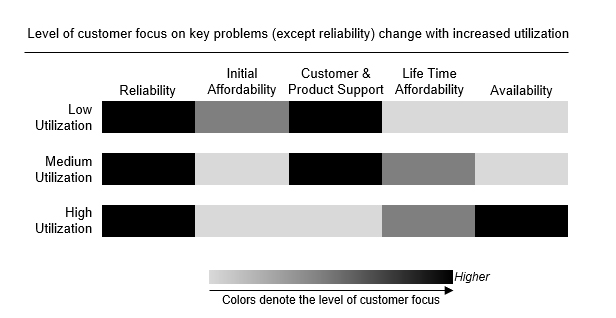Customer Problems Solved by Digitalization Across Various Markets
By Aytek Yuksel, Content Marketing Leader - Power Systems

If you work for a company where a power system – in this case, defined as an engine or power generator – Is powering your boats, locomotives, mining equipment or buildings such as hospitals, small businesses or data centers, it is highly likely that you’re familiar with new digital products or solutions. These digital offerings could be sensors, telematics, app-based solutions or cloud-based services.
As you hear more about these new digital offerings, it is important to be aware of the various customer problems and challenges these offerings are designed to solve.
In this article, we’re going to focus on how these challenges and problems vary across markets, with a focus on industrial markets that use power systems (again, defined here as engines or power generators) as primary or emergency back-up power sources. To see the patterns in customer problems across these markets, we have categorized them into three groups driven by the utilization level of power systems in each market.
Low Utilization: Markets where power systems are seldomly running. For example, airports, data centers, commercial buildings and healthcare applications where power generators are used as emergency back-up power source, as needed. The availability of power is critical in several of these applications, yet the utilization of power generators would be low since the primary source of power is the utility in most cases.
Medium Utilization: Markets where power systems are running occasionally. For example, rail, marine, and oil and gas applications where engines are used as a primary source of power, but the application doesn’t continuously run.

High Utilization: Markets where power systems are near continuously running. For example, mining equipment with engines that run near continuously, or power plants that use power generators as prime source of electricity.
For customer needs, research indicates that reliability is the problem that consistently ranks as a top priority across all three categories. However, when you move from low to high utilization, initial affordability, customer and product support, life time affordability, and availability become more important, in that order. Let’s look at two examples spotlighting how these changes in customer needs become apparent in real life applications.

For customers in the mining industry, a high utilization segment, PrevenTech, a new digital monitoring and reporting solution by Cummins, provides advanced detection of potential equipment health issues. PrevenTech’s continuous analysis helps mitigate performance impacts and improve mine site productivity by streamlining maintenance and service planning. For example, Cummins was able to reduce annual unplanned downtime costs of trucks using Cummins PrevenTech in the range of several thousands of dollars for one mining customer. A real-life example on solving customer’s problems around availability and life time affordability.
Customers in the healthcare industry, a low utilization segment, can improve the reliability of their emergency back-up power source using Cummins Power Command Cloud. Additionally, customers benefit from pro-active product support available through this digital solution. Users of Cummins Power Command Cloud can check their system status, identify faults and access critical notifications via a tablet, smart phone or workstation. In summary, customers in low utilization segments, such as healthcare, get what they need the most with Power Command Cloud: Improved reliability and enhanced customer and product support.
Digital solutions solve a variety of customer problems across industrial markets. Read more about how companies serving industrial markets take different paths in their digital journeys.
Author Profiles

Aytek Yuksel, Content Marketing Leader - Power Systems
Aytek is a marketing leader at Cummins, focusing on technology and thought leadership. Since joining in 2008, he has held various marketing roles and now shares insights on markets, technologies, and energy transition. Aytek lives in Minneapolis with his wife and two kids.
Related Tags